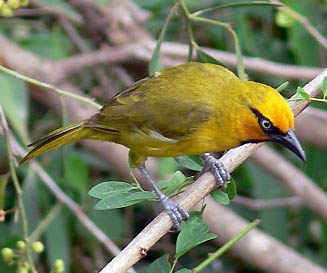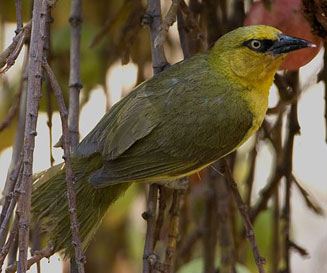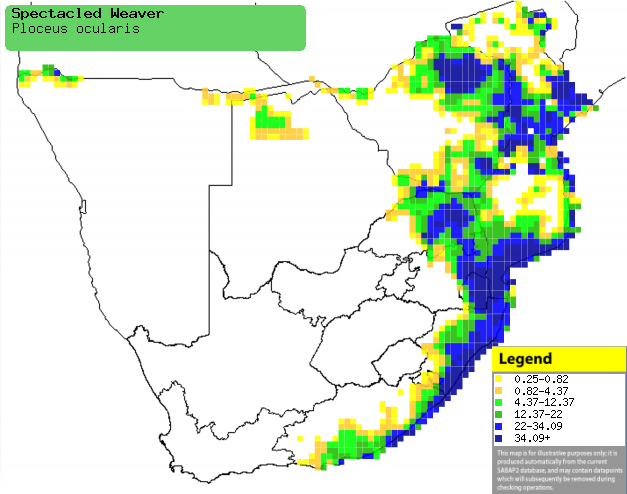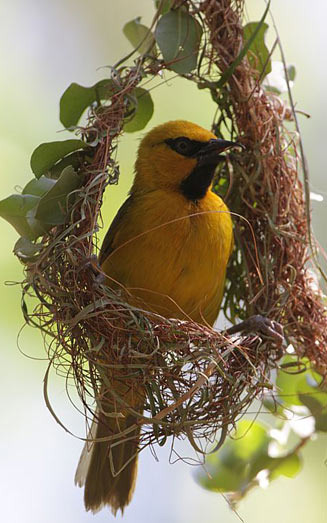|
Ploceus ocularis (Spectacled
weaver)
Brilwewer [Afrikaans]; Ikreza [Xhosa]; iGelegekle, iGeleja [Zulu];
Jesa (generic name for weaver) [Shona]; Sowa (generic term for weaver)
[Tsonga]; Thaga (generic term for weaver) [Tswana]; Brilwever [Dutch];
Tisserin à lunettes [French]; Brillenweber [German]; Tecelão-de-lunetas
[Portuguese]
Life
> Eukaryotes >
Opisthokonta
> Metazoa (animals) >
Bilateria >
Deuterostomia > Chordata >
Craniata > Vertebrata (vertebrates) > Gnathostomata (jawed
vertebrates) > Teleostomi (teleost fish) > Osteichthyes (bony fish) > Class:
Sarcopterygii (lobe-finned
fish) > Stegocephalia (terrestrial
vertebrates) > Tetrapoda
(four-legged vertebrates) > Reptiliomorpha > Amniota >
Reptilia (reptiles) >
Romeriida > Diapsida > Archosauromorpha > Archosauria >
Dinosauria
(dinosaurs) > Saurischia > Theropoda (bipedal predatory dinosaurs) >
Coelurosauria > Maniraptora > Aves
(birds) >
Order: Passeriformes > Family: Ploceidae
> Genus: Ploceus
 |
 |
|
Spectacled weaver male, South Africa. [photo
Tony Faria
©] |
Spectacled weaver female, Waterberg, South Africa.
[photo Trevor
Hardaker ©] |
Distribution and habitat
Occurs from Ethiopia to Cameroon south through southern DRC,
Zambia, Angola and Tanzania to southern Africa. Here it is locally common in
Zimbabwe, Mozambique, Swaziland and eastern and south-eastern South Africa, but
scarce in northern Botswana and Namibia. It generally prefers well-wooded
habitats with dense undergrowth, such as forest edges, woodland, vegetation
along rivers in thornveld, bushed valleys and gardens.
|
 |
|
Distribution of Spectacled weaver in southern Africa,
based on statistical smoothing of the records from first SA Bird Atlas
Project (©
Animal Demography unit, University of
Cape Town; smoothing by Birgit Erni and Francesca Little). Colours range
from dark blue (most common) through to yellow (least common).
See here for the latest distribution
from the SABAP2. |
Brood parasites
It has been recorded as host of the
Diderick
cuckoo.
Food
It mainly eats insects supplemented with nectar and fruit,
doing most of its foraging in vegetation, gleaning prey from bark and leaves. It
also hawks termite alates aerially, and often joins mixed-species foraging
flocks along with other insectivorous and frugivorous birds. The following food items have been recorded
in its diet:
- Invertebrates
- Plants
- nectar
- Aloe marlothii (Mountain aloe)
- Aloe ferox (Bitter aloe)
- Tecoma capensis (Cape honeysuckle)
- Schotia brachypetala (Weeping boer-bean)
- Erythrina latissima (Broad-leaved coral-tree)
- fruit
- Bread and bird seed at bird feeders
Breeding
- Monogamous, territorial solitary nester, as pairs stay bonded over
multiple breeding seasons, possibly for life.
- The nest is built solely by the male or occasionally by both sexes in
about 2-3 weeks, consisting of a retort-shaped structure with an
exceptionally long vertical entrance tunnel, usually 10-20 but sometimes
60cm long! It is usually woven from thin strips of plant material, but it
may be built with only pine (Pinus) needles or horse hair. It is
typically attached to the tip of a branch or creeper, especially if
overlooking a stream, rarely using a patch of reeds or grass instead.
 |
|
|
Spectacled weaver male in a ring, which is the
first stage of nest construction, at Kunene River Lodge, Namibia.
[photo Trevor
Hardaker ©] |
|
- Egg-laying season is from September-March, peaking from October-February.
- It lays 1-4 eggs, which are incubated by both sexes for about 13-14
days.
- The chicks are fed by both parents, leaving the nest after about 15-19
days and becoming fully independent about two weeks later.
Threats
Not threatened.
References
-
Hockey PAR, Dean WRJ and Ryan PG 2005. Roberts
- Birds of southern Africa, VIIth ed. The Trustees of the John Voelcker
Bird Book Fund, Cape Town.
|
